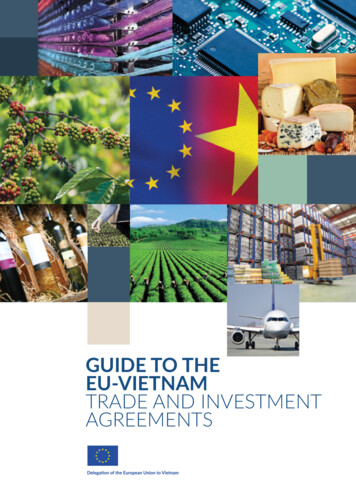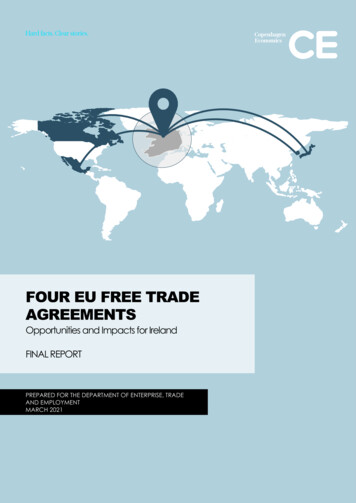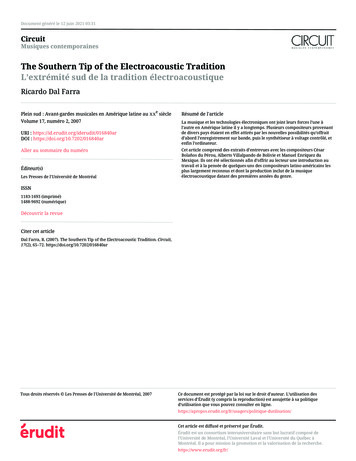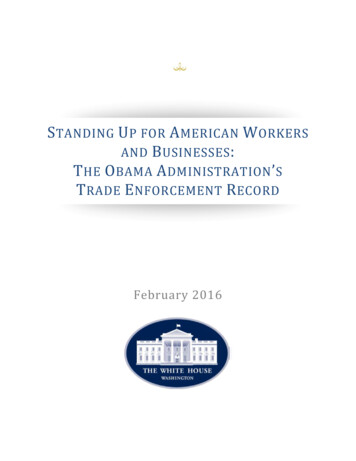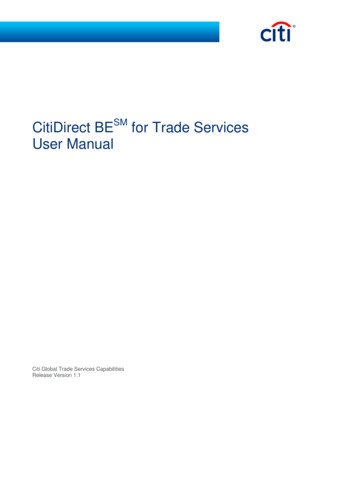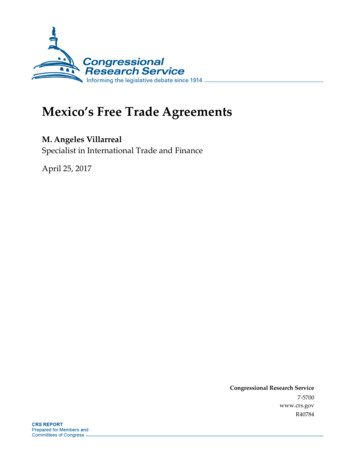
Transcription
Mexico’s Free Trade AgreementsM. Angeles VillarrealSpecialist in International Trade and FinanceApril 25, 2017Congressional Research Service7-5700www.crs.govR40784
Mexico’s Free Trade AgreementsSummaryMexico has had a growing commitment to trade integration and liberalization through theformation of free trade agreements (FTAs) since the 1990s, and its trade policy is among the mostopen in the world. Mexico’s pursuit of FTAs with other countries not only provides economicbenefits, but could also potentially reduce its economic dependence on the United States. TheUnited States is, by far, Mexico’s most significant trading partner. Approximately 80% ofMexico’s exports go to the United States, and about 47% of Mexico’s imports are supplied by theUnited States. In an effort to increase trade with other countries, Mexico has a total of 11 freetrade agreements involving 46 countries. These include agreements with most countries in theWestern Hemisphere, including the United States and Canada under the North American FreeTrade Agreement (NAFTA), Chile, Colombia, Costa Rica, Nicaragua, Peru, Guatemala, ElSalvador, and Honduras. In addition, Mexico has negotiated FTAs outside of the WesternHemisphere and entered into agreements with Israel, Japan, and the European Union.Economic motivations are generally the major driving force for the formation of free tradeagreements among countries, but there are other reasons countries enter into FTAs, includingpolitical and security factors. One of Mexico’s primary motivations for its unilateral tradeliberalization efforts of the late 1980s and early 1990s was to improve economic conditions in thecountry, which policymakers hoped would lead to greater investor confidence, attract moreforeign investment, and create jobs. Mexico could also have other reasons for entering into FTAs,such as expanding market access and decreasing its reliance on the United States as an exportmarket. The slow progress in multilateral trade negotiations may also contribute to the increasinginterest throughout the world in bilateral and regional free trade agreements under the WorldTrade Organization (WTO). Some countries may see smaller trade arrangements as “buildingblocks” for multilateral agreements.Since Mexico began liberalizing trade in the early 1990s, its trade with the world has risenrapidly, with exports increasing more rapidly than imports. Mexico’s exports to all countriesincreased 515% between 1994 and 2016, from 60.8 billion to 373.9 billion. Although the 2009economic downturn resulted in a decline in exports, the value of Mexican exports recovered inthe years that followed. Total imports also increased rapidly, from 79.3 billion in 1994 to 387.1billion in 2016, an increase of 388%. The trade balance went from a deficit of 18.5 billion in1994 to surpluses of 7.1 billion and 6.5 billion in 1995 and 1996. Since 1998, Mexico’s tradebalance has remained a deficit, equaling 13.2 billion in 2016. Mexico’s top five exports in 2016were passenger motor vehicles, motor vehicle parts, motor vehicles for the transport of goods,automatic data processing machines, and electrical apparatus for telephones. Mexico’s top fiveimports were motor vehicle parts, refined petroleum oil products, electronic integrated circuits,electric apparatus for telephones, and automatic data processing machines.In the 115th Congress, issues of concern related to the trade and economic relationship withMexico may involve a possible renegotiation of the North American Free Trade Agreement(NAFTA) and its effects, Mexico’s external trade policy with other countries, Mexico’s intentionsof moving forward with multilateral or bilateral free trade agreements with Asia Pacific countries,economic conditions in Mexico and the labor market, and the status of Mexican migration to theUnited States. This report provides an overview of Mexico’s free trade agreements, itsmotivations for trade liberalization and entering into free trade agreements, and trade trends withthe United States and other countries in the world.Congressional Research Service
Mexico’s Free Trade AgreementsContentsIntroduction . 1Motivations for Trade Integration . 1Mexican Trade Liberalization. 2Mexico’s Free Trade Agreements . 4NAFTA. 4Mexico-Chile. 5Mexico-European Union . 5Mexico-European Free Trade Association . 6Mexico-Uruguay . 7Mexico-Japan . 7Mexico-Colombia . 8Mexico-Israel . 9Mexico-Peru . 9Mexico-Central America . 10Mexico-Panama. 10Other Agreements . 11Proposed Trans-Pacific Partnership Agreement . 11Pacific Alliance . 11Mexico-Bolivia Economic Complementation Agreement . 12Partial Scope Agreements . 12Mexico’s Merchandise Trade . 14Economic Policy Challenges for Mexico . 16Implications for U.S. Interests . 16FiguresFigure 1. Mexico’s Trade Agreements. 3Figure 2. Mexico’s Merchandise Trade: 1995-2016. 15Figure 3. Mexico’s Exports and Imports by FTA Partner . 15TablesTable 1. Mexico’s Partial Scope Agreements . 13Table 2. Composition of Merchandise Trade: 2016. 14ContactsAuthor Contact Information . 17Congressional Research Service
Mexico’s Free Trade AgreementsIntroductionRegional trade agreements (RTAs) throughout the world have increased since the early 1990s.Many members of the World Trade Organization (WTO) are focusing on regional or bilateral freetrade agreements as a key component of their foreign and commercial policy.1 This interest isevident among industrialized and developing countries, and throughout various world regions.Mexico is a member of the WTO, which permits members to enter into regional trade integrationarrangements under certain conditions that are defined within specific WTO rules.2Since the early 1990s, Mexico has had a growing commitment to trade liberalization and has atrade policy that is among the most open in the world. Mexico has actively pursued free tradeagreements (FTAs) with other countries to help promote economic growth, but also to reduce itseconomic dependence on the United States. The United States is, by far, Mexico’s mostsignificant trading partner. Over 80% of Mexico’s exports are destined for the United States. In aneffort to increase trade with other countries, Mexico has entered into 11 free trade agreementswith 46 countries.3 Mexico is a signatory to the Trans-Pacific Partnership (TPP), a proposed freetrade agreement (FTA) signed by 12 Asia-Pacific countries on February 4, 2016, after eight yearsof negotiation. It would require congressional ratification before it could become effective. OnJanuary 30, 2017, the United States gave notice to the other TPP signatories that it does not intendto ratify the agreement, effectively ending the U.S. ratification process and TPP’s potential entryinto force, unless the Administration changes its position. Mexico and other TPP countries haveproposed moving forward on an FTA without the participation of the United States.4In the 115th Congress, congressional interest related to the trade and economic relationship withMexico may involve issues related to the North American Free Trade Agreement (NAFTA) and apossible renegotiation, the effects of NAFTA, Mexico’s ongoing efforts to form trade agreementswith other countries, the status of the proposed TPP and the possibility of its moving forwardwithout the United States, economic conditions in Mexico, Mexico’s labor market, and Mexicanmigration to the United States. This report provides an overview of Mexico’s free tradeagreements, its motivations for trade liberalization and entering into free trade agreements, tradetrends with the United States and other countries, and some of the issues Mexico faces inaddressing its economic challenges. This report will be updated as events warrant.Motivations for Trade IntegrationEconomic motivations are generally the major driving force for the formation of free tradeagreements among countries, but there are other reasons countries enter into FTAs, includingpolitical and security factors. Mexico’s primary motivation for the unilateral trade liberalizationefforts of the late 1980s and early 1990s was to improve economic conditions in the country,which policymakers hoped would lead to greater investor confidence and attract more foreigninvestment. This motivation was a major factor in negotiating NAFTA with the United States andCanada. The permanent lowering of trade and investment barriers and predictable trade rules1See CRS In Focus IF10002, The World Trade Organization, by Ian F. Fergusson and Rachel F. Fefer.For more information on the specific sets of rules governing regional trade agreements among WTO members, seeRegional Trade Agreements: Rules on the WTO website, available at http://www.wto.org.3World Trade Organization (WTO), Regional Trade Agreement Database, available at http://www.wto.org; andOrganization of American States, Foreign Trade Information System, available at http://www.sice.oas.org.4See CRS In Focus IF10000, TPP: Overview and Current Status, by Brock R. Williams and Ian F. Fergusson.2Congressional Research Service1
Mexico’s Free Trade Agreementsprovided by FTAs can improve investor confidence in a country, which helps attract foreign directinvestment (FDI). Multinational firms invest in countries to gain access to markets, but they alsodo it to lower production costs.Mexico has other motivations for continuing trade liberalization with other countries, such asexpanding market access for its exports and decreasing its reliance on the United States as anexport market. By entering into trade agreements with other countries, Mexico is seeking toachieve economies of scale in certain sectors of the economy and to expand its export market.FTAs provide partners with broader market access for their goods and services. Countries canbenefit from trade agreements, because producers are able to lower their unit costs by producinglarger volumes for regional markets in addition to their own domestic markets. When more unitsof a good or a service can be produced on a larger scale, companies are able to decrease cost ofproduction.Mexico’s high dependence on the United States as an export market is a likely motivation forseeking FTAs and other regional trade arrangements with other countries. The slow progress inmultilateral negotiations in the WTO may be another likely factor. Some countries see smallertrade arrangements as “building blocks” for multilateral agreements. Other motivations could bepolitical. Mexico may be seeking to demonstrate good governance by locking in political andeconomic reforms through trading partnerships.Mexican Trade LiberalizationFrom the 1930s through part of the 1980s, Mexico maintained a strong protectionist trade policyin an effort to be independent of any foreign power and as a means to promote domestic-ledindustrialization. Mexico established a policy of import substitution in the 1930s, consisting of abroad, general protection of the entire industrial sector through tight restrictions on foreigninvestment and by controlling the exchange rate to encourage domestic industrial growth. Mexicoalso nationalized the oil industry at this time. These protectionist economic policies remained ineffect until the country began to experience a series of economic challenges several decades later.In the mid-1980s, Mexico’s economy was on the verge of collapse as a result of the 1982 debtcrisis in which the Mexican government was unable to meet its foreign debt obligations. Much ofthe government’s efforts in addressing these economic challenges were placed on privatizing stateindustries and moving toward trade liberalization. Mexico had few options but to open itseconomy through trade liberalization. In the late 1980s and early into the 1990s, Mexicoimplemented a series of measures to restructure the economy that included unilateral tradeliberalization, replacing import substitution policies with others aimed at attracting foreigninvestment, lowering trade barriers, and making the country competitive in non-oil exports. In1986, it acceded to the General Agreement on Tariffs and Trade (GATT), assuring further tradeliberalization measures that led to closer ties with the United States.Mexico and the United States began NAFTA negotiations in the early 1990s. Canada later joinedthe negotiations and the three countries signed the agreement on December 17, 1992. BeforeNAFTA came into force Mexico had already entered into its first agreement for free trade ingoods, the Mexico-Chile FTA. NAFTA entered into force with much broader provisions than theChile FTA, such as trade in services, government procurement, dispute settlement procedures,and intellectual property rights protection. In 1999, the original text of the Mexico-Chile FTA wascomplemented with broader provisions, similar to those under NAFTA. Mexico’s initialmotivation in pursuing FTAs with the United States and other countries was to stabilize theMexican economy, which had experienced many difficulties throughout most of the 1980s with aCongressional Research Service2
Mexico’s Free Trade Agreementssignificant deepening of poverty. The expectation in Mexico was that FTAs would increase exportdiversification; attract FDI; and help create jobs, increase wage rates, and reduce poverty.Figure 1. Mexico’s Trade AgreementsAgreements (As of April 7, 2017)DateSignedDate Enteredinto ForceNAFTA (Mexico, Canada, United States)Dec. 17, 1992Jan. 1, 1994ChileApril 17, 1998Aug. 1, 1999European Union (Austria, Belgium, Bulgaria, Croatia, Cyprus, CzechRepublic, Denmark, Estonia, Finland, France, Germany, Greece, Hungary,Ireland, Italy, Latvia, Lithuania, Luxembourg, Malta, Netherlands, Poland,Portugal, Romania, Slovakia, Slovenia, Spain, Sweden, and United Kingdom)Dec. 8, 1997Oct. 1, 2000EFTA (Iceland, Liechtenstein, Norway, and Switzerland)Nov. 27, 2000July 1, 2001UruguayNov. 15, 2003July 15, 2004JapanSept. 17, 2004April 1, 2005ColombiaJune 13, 1994Jan. 1, 2011IsraelApril 10, 2000Feb. 1, 2012PeruApril 6, 2011Feb. 1, 2012Central America (Costa Rica, El Salvador, Guatemala, Honduras, andNicaragua)Nov. 22, 2011Sept. 1, 2013PanamaApril 3, 2014July 1, 2015Source: Trade agreement information from World Trade Organization, Regional Trade Agreement Database, athttp://www.wto.org; and Organization of American States, Foreign Trade Information System, athttp://www.sice.oas.org. Map created by CRS.Notes: The WTO definition of a free-trade area is a group of two or more customs territories in which theduties and other restrictive regulations of commerce (except, where necessary, those permitted under ArticlesXI, XII, XIII, XIV, XV, and XX of the GATT) are eliminated on substantially all the trade between the constituentterritories in products originating in such territories.Congressional Research Service3
Mexico’s Free Trade AgreementsMexico’s Free Trade AgreementsMexico’s pursuit of free trade agreements with other countries is a way to bring benefits to theeconomy, but also to reduce its economic dependence on the United States. The United States is,by far, Mexico’s most significant trading partner. Approximately 80% of Mexico’s exports go tothe United States and 47% of Mexico’s imports come from the United States.5 In an effort todiversify and increase trade with other countries, Mexico has a total of 11 trade agreementsinvolving 46 countries (see Figure 1). These include agreements with many countries in theWestern Hemisphere including the United States and Canada, Chile, Colombia, Peru, andUruguay.6 Mexico has also ratified an FTA with Central America (Costa Rica, El Salvador,Honduras, Guatemala, and Nicaragua) that was signed on November 22, 2011. As of September1, 2013, the FTA had entered into force among all 6 parties.Mexico has also negotiated free trade agreements outside of the Western Hemisphere and, in July2000, entered into agreements with Israel and the European Union. Mexico became the first LatinAmerican country to have preferential access to these two markets. Mexico has completed a tradeagreement with the European Free Trade Association of Iceland, Liechtenstein, Norway, andSwitzerland. The Mexican government expanded its outreach to Asia in 2000 by entering intonegotiations with Singapore, Korea, and Japan. In 2004, Japan and Mexico signed an EconomicPartnership Agreement, the first comprehensive trade agreement that Japan signed with anycountry.7 However, the large number of trade agreements has not yet been successful insignificantly decreasing Mexico’s dependence on trade with the United States.NAFTAThe North American Free Trade Agreement has been in effect since January 1, 1994. Theagreement was signed in December 1992; NAFTA side agreements were signed in August 1993.8At the time that NAFTA was implemented, the U.S.-Canada FTA was already in effect and U.S.tariffs on most Mexican goods were low. NAFTA opened up the Mexican market to the UnitedStates and Canada, creating the largest single market in the world. Some tariffs were eliminatedimmediately, while others were phased out in various schedules of 5 to 15 years. NAFTAprovided the option of accelerating tariff reductions. It eliminated quotas and import licenses. Itestablished rules on duty drawback programs, terminating all existing drawback programs byJanuary 1, 2001. The agreement also contained provisions for market access in goods, agriculture,and most service sectors; foreign direct investment; intellectual property rights protection;sanitary and phytosanitary measures; government procurement; antidumping and countervailingduty matters; land transportation; dispute resolution; and special safeguard mechanisms. NAFTAwas the first major free trade agreement that addressed environmental and labor concerns byincluding related provisions in separate side agreements that entered into force at the same timeas NAFTA.5Mexican government data from the Subsecretaría de Comercio Exterior.Mexico and Bolivia had a previous FTA that entered into force on January 1, 1995. The FTA was terminated 16 yearslater on June 7, 2010, at the request of the Bolivian government. The current agreement for Mexico and Bolivia is an“Economic Complementation Agreement”, which ended most FTA provisions but maintained the same tariff levels ongoods as the previous FTA.7The Asahi Shimbun, “Japan: Free Trade with Mexico,” March 12, 2004.8See CRS Report R42965, The North American Free Trade Agreement (NAFTA), by M. Angeles Villarreal and Ian F.Fergusson, and CRS In Focus IF10047, North American Free Trade Agreement (NAFTA), by M. Angeles Villarreal.6Congressional Research Service4
Mexico’s Free Trade AgreementsNAFTA provisions required that partner countries eliminate all non-tariff barriers to agriculturaltrade, either through their conversion to tariff-rate quotas (TRQs) or ordinary tariffs. Mexicoremoved or replaced its import license requirements with TRQ’s and gradually phased these outover a 10-year period. Approximately one-half of U.S.-Mexico agricultural trade became dutyfree when the agreement went into effect. Sensitive products receiving longer phase-outschedules of 14 to 15 years included sugar, corn, dry beans, frozen concentrated orange juice,winter vegetables, and peanuts. Trade in sugar, one of the most sensitive issues in the tradenegotiations, received the longest TRQ phase-out period of 15 years. NAFTA included specialsafeguard provisions in which a partner country could apply the tariff rate in effect at the time theagreement entered into force if imports of a product reached a “trigger” level set out in theagreement.Mexico-ChileThe Mexico-Chile FTA, completed in 1998, was enacted in Chile on July 7, 1999, and in Mexicoon August 1, 1999. Mexico and Chile signed the agreement at the 1998 Summit of the Americasin Santiago, Chile, on April 17, 1998. The FTA was expected to deepen the growing traderelationship between the two countries and improve bilateral investment opportunities in bothcountries. The 1998 agreement replaced an earlier FTA that was reached between the twocountries in 1991. It removed tariffs on almost all merchandise trade between the two countries.The Mexico-Chile FTA includes provisions on national treatment and market access for goodsand services; rules of origin; customs procedures; safeguards; standards; agriculture; sanitary andphytosanitary measures; investment; air transportation; telecommunications; temporary entry forbusiness persons; IPR; dispute resolution; and other provisions. It does not include a chapter onenergy, environment, or labor.9 A separate agreement, which was signed simultaneously, includesprovisions to avoid double taxation for companies doing business in both countries. The FTAprovisions are similar to those under NAFTA, but with no labor and environmental provisions.Other provisions that are not part of the FTA include financial services, patents, and governmentprocurement.10Mexico-European UnionThe trade relationship between Mexico and the European Union (FTA) is governed by a free tradeagreement that entered into force on July 1, 2000, formally called the Economic PartnershipPolitical Coordination and Cooperation Agreement and now known as the Global Agreement.Negotiations for the FTA began in October 1996 and the agreement was signed in March 2000.The motivations for the agreement were to expand market access for exports from the EU toMexico and attract more FDI from the EU to Mexico.11 Since the entry into force of the GlobalAgreement, the two parties have entered into FTAs with other countries with updated provisions.Mexico and the EU agreed to conduct scoping exercises to determine whether the FTA neededmodernizing to include provisions in more recent agreements that they had negotiated. In June2015, the two parties announced that they would be launching negotiations for a new FTA.9Decreto Promulgatorio del Tratado de Libre Comercio entre el Gobierno de los Estados Unidos Mexicanos y elGobierno de la República de Nicaragua. See WTO Regional Trade Agreement Database, http://www.wto.org.10Bureau of National Affairs (BNA), International Trade Reporter, “Mexico and Chile Sign Off on Expanded TradeAgreement,” April 22, 1998.11Reuters, “Cumbre-México y Unión Europea Acuerdan Acelerar Libre Comercio,” May 17, 2008.Congressional Research Service5
Mexico’s Free Trade AgreementsGiven the perceived possibility of a rising protectionist sentiment in the United States, someregional experts have suggested that Mexico and the European Union should seek to moreaggressively negotiate new FTAs and deepen existing ones.12 On May 25, 2016, Mexico and theEU launched negotiations to renegotiate and modernize the Mexico-EU FTA. The initiative ismeant to build on the existing FTA by drawing on FTAs with other countries. In February 2017,the EU Commissioner and Mexico’s Minister of Economy announced that they would acceleratetrade talks. They stated their intention to take their trade relations into the 21st Century anddeepen their openness to trade. Discussions have been held on government procurement, energytrade, IPR protection, rules of origin, and small- and medium-sized businesses.13The current Mexico-EU Global Agreement includes provisions on national treatment and marketaccess for goods and services; government procurement; IPR; investment; financial services;standards; telecommunications and information services; agriculture; dispute settlement; andother provisions. The agreement also includes chapters on cooperation in a number of areas,including mining, energy, transportation, tourism, statistics, science and technology, and theenvironment.14 On industrial goods, the EU agreed to eliminate tariffs on 82% of imports byvalue coming from Mexico on the date of entry into the agreement and to phase out remainingtariffs by January 1, 2003. Mexico agreed to eliminate tariffs on 47% of imports by value fromthe EU upon implementation of the agreement and to phase out the remaining tariffs by January1, 2007. In agricultural products and fisheries, signatories agreed to phase out tariffs on 62% oftrade within 10 years.15 Tariff negotiations were deferred on certain sensitive products, includingmeat, dairy products, cereals, and bananas. Most non-tariff barriers, such as quotas andimport/export licenses, were removed upon implementation of the agreement. Mexico agreed tophase out import restrictions of new automobiles from the EU by 2007. In governmentprocurement, Mexico agreed to follow provisions similar to those under NAFTA to allow the EUto enter the Mexican market while the EU agreed to follow WTO rules.16 In services trade, theagreement goes beyond the WTO General Agreement on Trade in Services (GATS). Itimmediately provided European service operators “NAFTA-equivalent” access to Mexico in anumber of areas, including financial services, energy, telecommunications, and tourism.17Mexico-European Free Trade AssociationMexico and the European Free Trade Association (EFTA), composed of Iceland, Lichtenstein,Norway, and Switzerland, signed a free trade agreement on November 27, 2000. The agreemententered into force on July 1, 2001. This was the first FTA that the EFTA had concluded with anoverseas partner country. Since the agreement entered into force, Mexico and the EFTA have metat least four times to explore possibilities of further trade integration, including agricultural andservices trade. In September 2008, the two parties agreed to adopt an amendment on12“Former Latin American Officials: Shift Trade Focus to EU and Asia over U.S.,” World Trade Online, April 5, 2017.European Commission, EU and Mexico Agree to Accelerate Trade Talks, Brussels, Belgium, February 1, cfm?id 1617.14Global Agreement, Economic Partnership, Political Coordination and Cooperation Agreement between the EuropeanCommunity and its member States and the United Mexican States. See WTO Regional Trade Agreement Database, seehttp://www.wto.org.15The Chinese University of Hong Kong, The Mexico-EU Free Trade Agreement, 2000, http://intl.econ.cuhk.edu.hk.16Transnational Institute, Mexican Action Network on Free Trade (RMALC), The EU-Mexico Free Trade AgreementSeven Years On, June 2007.17U.S.-Mexico Chamber of Commerce, The Free Trade Agreement Between Mexico and the European Union, August2000.13Congressional Research Service6
Mexico’s Free Trade Agreementstransportation to the agreement to help facilitate trade. They also discussed possibilities of furtheramendments, such as banning export duties and extending the coverage of trade in processedagricultural products.18The agreement includes provisions on national treatment and market access for goods;agriculture; rules of origin; safeguards; and other provisions.19 During the first six years, the FTAreduced the average Mexican tariff on EFTA industrial goods from 8% to zero. Mexicanindustrial exports to the EFTA have been free of duty since the entry into force of the FTA.20Mexico-UruguayOn November 15, 2003, the presidents of Mexico and Uruguay signed the Mexico
Apr 25, 2017 · migration to the United States. This report provides an overview of Mexico’s free trade agreements, its motivations for trade liberalization and entering into free trade agreements, trade trends with the United States and other countries, and some of the i
